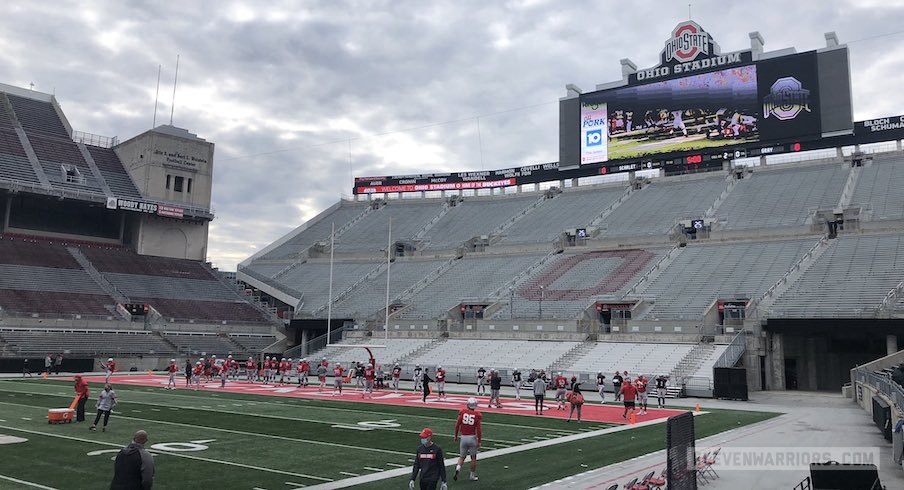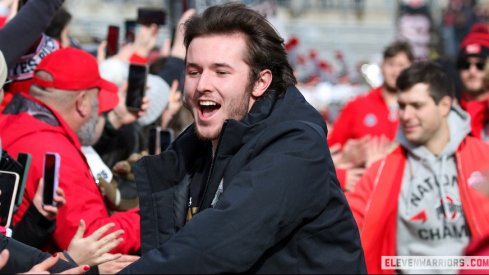If Ohio State had made a decision on its own about whether fans could attend games at Ohio Stadium this season, there likely would have been more than 20,000 fans in the Shoe for Saturday’s season opener against Nebraska.
As Ohio State planned this summer for the possibility of playing football games amid the ongoing COVID-19 pandemic, it was hopeful that it would be able to host approximately 22,000 fans while adhering to physical distancing guidelines. Spacing out “pods” of tickets sold together would have limited Ohio Stadium to a small fraction of its normal capacity, but through his conversations with City of Columbus health commissioner Mysheika Roberts, athletic director Gene Smith was confident Ohio State would be able to garner approval for a plan that would enable a limited number of fans to attend games.
The Big Ten, however, ultimately made a collective decision that no tickets would be sold to the public for this season’s football games. Because some Big Ten states currently have stricter restrictions in place than others, it was decided that attendance at games should be limited only to guests of players and coaches and people who are at the stadium in a working capacity.
“We felt that every school should be in the same boat,” Smith said Monday. “We decided as a league that the parents of the players and coaching staff were the highest priority. So when you look at Rutgers, for example, I think their limit is 500 people in the stands. And Penn State is somewhere in that neighborhood (750 people). So when you look at each player gets four tickets each, and then you add in the families of the coaches, you’re a little bit over 1,000 right there. So we just felt like we gotta take care of them first.
“We just felt like we needed to be consistent, and not have a crowd competitive advantage.”
As a result, Ohio Stadium – which typically hosts more than 100,000 fans at every home game – will be operating with a capacity of just 1,600 people, which includes everyone in the stadium, on Saturday. Ohio State players’ and coaches’ families will receive a total of 656 tickets, while the visiting team will receive up to 400 tickets for its guests. In addition to the teams themselves, the rest of the capacity will include stadium staff, public safety officials, TV network staff and 40 media members in the press box, down from 230 in a typical season.
That total won’t include The Best Damn Band in the Land or Brutus Buckeye, as the Big Ten also decided as a conference that marching bands and cheerleading squads won’t be permitted at games due to capacity restrictions. Smith said that if the Big Ten ultimately eases its restrictions before the end of the season, though, bringing TBDBITL back to the Horseshoe would be the first order of business.
“If there’s relief as we move forward, the band would be our highest priority,” Smith said. “That would be our first 300 (additional people) that we’d go for. Then we’d cascade from there.”
Whether those restrictions actually will be eased at some point between Saturday’s season opener and the Dec. 12 regular-season finale against Michigan is uncertain, but Smith said the conference will evaluate what’s happening in each Big Ten state on a weekly basis to discuss whether schools should be permitted to host fans at their home games.
“I think every week, we’ll continue to evaluate what’s happening in other states,” Smith said. “New Jersey has some very stringent requirements right now, and Pennsylvania as well, Maryland. The state up north just lifted theirs a little bit. What we want is consistency.
“We decided that we’ll all be in this together, and I think we’ll just go week to week.”
For now at least, Ohio Stadium will be limited to less than 2 percent of its normal capacity for football games, which is going to make Saturday’s season opener look and feel much different than usual. There will be artificial crowd noise played at 70 decibels during the game, so the stadium won’t be quiet – Ryan Day said it could actually be louder between plays than it would be with a typical crowd – but the environment certainly won’t be the same without fans filling the stands and the band performing in person.
“It’s weird. I don’t know how else to explain it: It’s weird,” said Smith, who was at the Buckeyes’ most recent practice in an empty Ohio Stadium with crowd noise playing through the speakers. “Being down there with no fans in the stands, listening to the decibel levels, this is all new for all of us. It’s just weird. And I think it’s just gonna be weird all the way around.”
In terms of the game on the field, though, Ohio State is confident this year’s unusual protocol won’t affect the Buckeyes’ ability to perform on the field. Pregames will be different for the team; instead of spending the morning at the Blackwell Inn before busing over to St. John Arena for the Skull Session and then walking to Ohio Stadium, the Buckeyes will return to the Woody Hayes Athletic Center after staying overnight in an off-campus hotel and then bus to the Shoe from the WHAC. Both Smith and Day, though, believe that will actually be beneficial to the team because of the resources they have available to them at the Woody.
“Instead of taking all of our stuff over to the Blackwell, we have everything we need here,” Day said Tuesday. “We have our sports science, our cryogenics, our recovery, our float tanks, the cold and hot tubes, the bikes, the NormaTec boots, the training room, the indoor (field) for walkthroughs, dining facility to eat. We can spread it out a little bit more here. So I think the utilization of the Woody on Friday night and before the game, as we’ll kind of get ready here and then head over on the bus, there are certain aspects that’ll actually be more efficient.”
If things go as well as hoped this year, Smith considered the possibility that some of the changes to the Buckeyes’ pregame routine could be permanent, though they wouldn’t want that to come at the expense of the university’s storied traditions.
“It will be interesting when we’re hopefully back to normal, it will be interesting how we approach this, really. Because I personally think practically, it’s gonna be a better situation,” Smith said. “And you have more control. Now there’s certain things that we’ll have to do because of the traditions, but you might just stay overnight and go back to the WHAC and then go straight to the Skull Session, drop them off and go.”
For this year, though, Smith and his colleagues are just glad that they will be able to host games at Ohio Stadium this fall, even if it won’t be quite the same as what anyone’s used to.
“Our staff has been working really hard since the beginning of the summer, actually, on hosting of football games,” said assistant athletic director of event management Ericka Hoon. “We’re excited to put this into action. We’re sorry that we don’t get to welcome more people, but we are grateful that we have the opportunity to get a game on the field for our teams and for our student-athletes.”
Now that game week has finally arrived and the protocols are in place, Smith isn’t as concerned with how game operations will go as he is with how the Buckeyes will perform against the Cornhuskers, knowing their aspirations of competing for a national championship now that their opportunity to do so has been restored.
“I feel real comfortable with our protocols that we have in place now. Our coaches and student-athletes have been going through this for quite some time. So I feel good about that. My trepidation now is more about the game,” Smith said. “Normally, we have some, before you play a Big Ten game, you have a couple non-conference games and you have some film on your Big Ten opponent. We have no clue what Nebraska’s going to do. So I’ve kind of moved into football mode now.”


